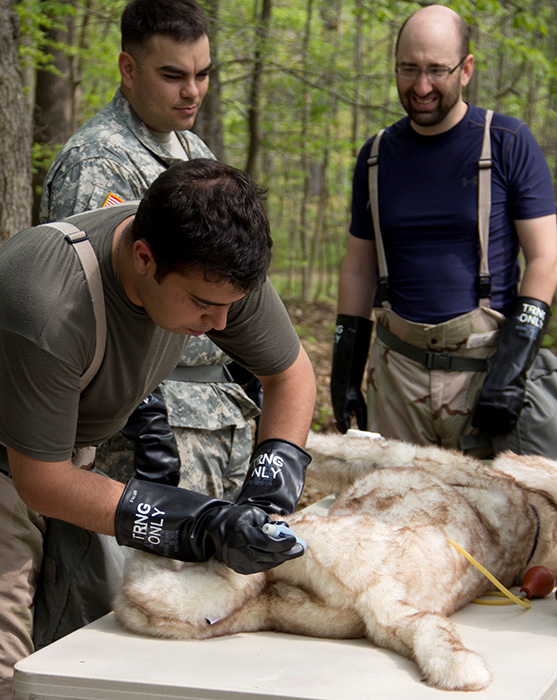USAMRICD Chemical Casualty Training Addresses Treatment of Military Working Dogs
Working dogs are a vital asset to the fighting force, as well as to civilian emergency responders, and they face the same dangers as their human handlers, to include exposure to chemical warfare agents on the battlefield or in a potential terrorist attack. In such a scenario, these canine victims would likely first be seen by forward medical teams that are unlikely to include a veterinarian.
So in 2013 when Veterinary Corps officer Maj. Matthew Wegner–then newly assigned to the U.S. Army Medical Research Institute of Chemical Defense (USAMRICD)–went through the USAMRICD's Medical Management of Chemical and Biological Casualties course, he saw an opportunity within the institute's training to provide instruction to members of the medical profession who may find themselves facing canine exposure casualties along with their human patients.
The objective was getting the medical professionals and first responders who attend the institute's medical and field management of chemical and biological casualty training to think about the issues and logistics involved in treating military working dogs (MWDs). Much of the information is applicable to other types of working dogs, service animals, and personal pets, which could be important in assisting municipal emergency preparedness teams in complying with the 2006 Pets Evacuation and Transportation Standards Act. The act requires that preparedness plans for major disasters or emergencies address the rescue, care and shelter of pets and service animals.
Wegner approached the USAMRICD's Chemical Casualty Care Division (CCCD), which develops and provides both the Medical Management and Field Management of Chemical and Biological Casualty courses. The division was enthusiastic about adding MWD-focused instruction to the training, particularly since its staff had been fielding questions from the combatant commands about MWD exposures, and they suggested that Wegner prepare the lecture.
While the institute's courses already packed a lot of information and exercises into the week-long training, with little room for additions, the presentation "Military Working Dogs and the CBRNE Environment" was worked in as a lunchtime lecture. In the four years since the initial lecture, several refinements have been made to the MWD-specific training, and to supplement the classroom instruction, a station on MWDs was eventually added to each course's practical field exercise, complete with two canine manikins. Additionally, several of USAMRICD's Veterinary Corps officers now rotate as the lecture presenter.
"Our medical and field management courses are continually evolving to answer the Warfighter's critical needs with the goal of meeting our Nation's challenges," said Timothy Byrne, director of CCCD's courses. "This particular lecture and associated field training addresses the unique challenge of how the possible use of chemical warfare agents or toxic industrial chemicals during a terrorist incident or in a time of war could impact our Nation's elite K9 working dogs."
"The response from operators and medical personnel alike has been extremely positive," continued Byrne. "One operator said to me about the course, ‘Just what we needed during this critical time in Afghanistan. Our dogs are at great risk from the opioid fields, pesticides, etc.!'"
The training covers safety issues, special considerations, the effects of the agents in dogs, and decontamination. Students are reminded that an exposed MWD is experiencing stress like any other casualty, especially if its handler has been injured, so the first safety consideration is to muzzle the dog to avoid being bitten. Not only are dog bites painful, the lecture points out, but they can be serious enough to make the caregiver a patient, and further, to compromise the caregiver's protective, or MOPP (Mission Oriented Protective Posture), clothing, thus exposing that individual to the contaminated environment. In the field exercise, students learn how to use gauze to muzzle the dog, if its regular muzzle is not available.
The signs and symptoms of exposure in dogs are similar to those in humans, and while the only treatments that exist have been developed for humans, students learn how to adjust the doses of these antidotes when treating a MWD. The field exercise provides training in properly administering the fielded autoinjectors to the animal, using the simulated canine.
Additionally, students learn some notable differences between canine and human exposures. For example, a dog's fur slows absorption of the chemical through its skin; however, the dog will be more sensitive to exposure on other areas, such as its paws, its axilla (or armpit) and on its belly. A dog can also be exposed by licking itself or the ground or by eating and drinking contaminated food and water.
Information on decontamination includes what products can and cannot be used on canines, the most efficient procedure (head to tail), and how to prevent re-contamination, for example, by placing the dog in a covered transportable kennel after it is decontaminated. The lecture also gives suggestions for providing protection for dogs that must work in a contaminated environment. These include using ponchos to cover the dog's body or using specimen bags, MRE bags, or extra butyl rubber gloves wrapped with tape to cover the dog's paws.















